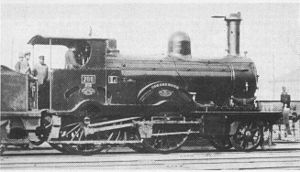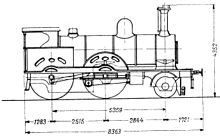StEG II 200
| StEG II 200 / StEG III 2051 | |
|---|---|
|
STEG II 200 COMBERMERE
|
|
| Numbering: | StEG II 200 StEG III 2051 |
| Number: | 1 |
| Manufacturer: | Sharp |
| Year of construction (s): | 1884 |
| Axis formula : | 1Bo n3v |
| Gauge : | 1435 mm ( standard gauge ) |
| Length over buffers: | 8,363 mm |
| Height: | 4,352 mm |
| Total wheelbase: | 5,359 mm |
| Service mass: | 39.0 t |
| Friction mass: | 28.0 t |
| Driving wheel diameter: | 1,980 mm |
| Control type : | Joy |
| Number of cylinders: | 3 |
| HD cylinder diameter: | 330 mm |
| LP cylinder diameter: | 660 mm |
| Piston stroke: | 610 mm |
| Boiler overpressure: | 9.0 atm |
| Grate area: | 1.56 m² |
| Evaporation heating surface: | 88.81 m² |
The StEG II 200 was an express train - steam locomotive with a tender of the State Railway Company (StEG) of Austria-Hungary .
This locomotive was the first Austrian composite locomotive that was not converted from a twin locomotive .
It was built in 1884 by Sharp in Manchester for StEG. It had two high-pressure cylinders which were arranged outside behind the running wheels and which drove the second drive axle. The low-pressure cylinder was located above the barrel axis and drove the first drive axle. The standing boiler reached deep between the driving axes, but had a grate area that was far too small for the poor quality Austrian coal. Therefore the steam generation left a lot to be desired. In addition, the machine had a slight tendency to skid when starting up.
In summary, the locomotive was absolutely unsuccessful and was soon shut down.
When it was delivered, it was initially given the road number 161 and the name COMBERMERE , from 1885 the number 208 and only from 1886 the final number 200. In the third StEG scheme from 1897, the individual item was given the designation 2051.
literature
- Erich Metzeltin : The development of the locomotive in the area of the Association of German Railway Administrations . 2nd volume. Oldenbourg, Munich and Berlin 1937.

